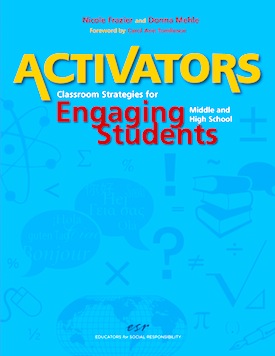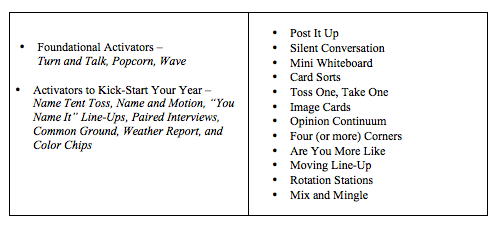Activators for the Real World of Today’s Classrooms
Activators: Classroom Strategies for Engaging Middle and High School Students
By Nicole Frazier and Donna Mehle
(Engaging Schools, 2013 – Learn more)

Summer. The time to which students and teachers look forward. (Yes, even in the summer, it’s best not to end a sentence with a preposition.)
For most, the very essence of summer is desired for its freedom from structure, deadlines, and expectations. But it is an ingrained fear of lack of structure, missed deadlines, and ignored expectations in the classroom that interrupts my summertime dreams with nightmares of fall, replete with jolting scenes of unruly, defiant, and disengaged students that I must train to function successfully in an academic setting…when all they want is the return of summer.

If you have been in a classroom for any amount of time, the concept of “activators” is nothing new. Frazier and Mehle define activators as “learning strategies that incorporate think time and purposeful social interaction to foster emotional, cognitive, and behavioral engagement” (1).
Although many of the activators they describe may be familiar, the authors go to great lengths to develop an invaluable teacher’s toolkit rather than simply another compilation of strategies from which to choose randomly.
When I pick up a book that designates its chapters by strategies, I tend to check out the table of contents and go to the chapters of interest. In this case, you will find the following activators:
However, if I were to read just the chapters of interest, I would miss what makes this text different from its counterparts: the purpose of activators.
The how and why of activators
In my eighth grade Language Arts classroom, I am guilty of looking for an activator that will work for a particular lesson. If it goes well, I might try it again at some other point. If it goes poorly, I might very well abandon it before the final bell rings.
In the opening chapters, Frazier and Mehle explore the “how” and “why” behind activators. As a result, I discovered that I often hyper-focus on the behavioral outcome and perhaps throw in the towel too early. The authors clearly advocate for the use of activators as consistently and strategically implemented learning strategies, not just as once-and-done activities. Additionally, while behavioral engagement is important, it still remains only one part of the activator trifecta. The emotional and cognitive aspects also play notable roles in students’ curricular experiences.
A thorough treatment
Frazier and Mehle offer a comprehensive approach to each activator with the caveat that the effectiveness of the teacher’s instruction and facilitation does impact the outcome. Within each activator-focused chapter, Frazier and Mehle address the following topics:
- A brief description and overview of the Activator
- Conditions for engagement that the Activator fosters
- A teacher prep list
- An Activator snapshot sketch to show how you will need to arrange students in your classroom
- Sample student directions to display
- Detailed teacher directions broken down into three parts: Set up the Activator, Model and Teach, and Practice and Assess
- Troubleshooting tips
- Variations and extensions
- Reasons for implementing the Activator along with content area examples
- A chart of content area examples for math, science, social studies, English language arts, and world languages
- Suggestions for writing your own content area Activators
- Work space for designing your own content area Activators (8)
I found this detail-oriented approach helpful since it really scaffolds the information. Newer teachers will feel confident when implementing these activators in the classroom, and veteran teachers will likely encounter a new thought or approach.
A book attuned to reality
I appreciated that Frazier and Mehle are realistic in their presentation. Too often when I read texts such as this, I wonder if the author has been in a classroom lately to see how students actually act. Here, the authors understand that we cannot pick and choose the types of learners we have. They offer redirection for when misbehaviors occur and suggest variations that might better meet the need of a particular mix of students.
Activators also includes implementation examples for all content area courses, so there really is something for everyone. Additionally, the final chapters offer yet more valuable resources: guidance on developing and implementing your own activators plan, Common Core aligned examples for the content areas, and even a variety of grouping strategies.
Best read in the summer, Activators: Classroom Strategies for Engaging Middle and High School Students will help ward off those back-to-school nightmares and allow you to achieve continued student engagement even in the deep, dark recesses of winter. Before you know it, summer will be right around the corner again.
Sarah Grieb earned undergraduate degrees in English Literature and Spanish from Lycoming College and her M.Ed in Curriculum and Instruction with an emphasis in Children’s Literature from The Pennsylvania State University. However, since 2004, her real educational experience has come through the teaching of hundreds of unique individuals in her 8th grade Language Arts classroom in the Central York School District (York, PA) as well as raising three of her own future middle school students.


































